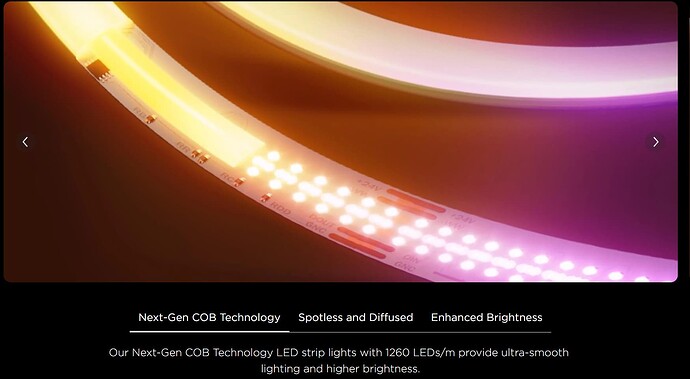Most of what you mention though isn't a pixel blaze thing, but a COB (LED) Strip thing and dependent on which one you get.
The only functional improvement I see mentioned is that the Pixel Blaze controller's driver can create 12 individual segments. Does it create child devices for those to appear and be controlled separately?
Totally agree as that is what I was also suggesting. That isn't a Pixel blaze thing
COB strips are certainly better at diffusing lights from exposed Pixels, but it isn't perfect. Pretty much every COB strip I have seen on amazon still has exposed flexible PCB on the sides of the Pixels and there diffusing strip. to expose cut points and show were you can solder wires to. The Govee Kit is that way as well but appear to include a cover to hide the exposed pads and PCB.
It is certainly possible when buying strips to get some with cut points and pads that are very close together but I have never seen it be at any spot at all. There have always been limits. The Govee COB strip looks like it may be a couple inches apart, so this can be upgraded upon with the right DIY strip.
That is completely dependent on the type of LEDs and ICs involved. If it is simply RGBIC then 3 is right GND, V+ and D. If there is also a white pixel that is not segmented it may be 4 or more if even more stuff is added.
The Govee COB strip controller is MATTER enabled so it will be 100% local as well. Light Effects will use the LAN API so they will be local as well.
This is a requirement for COB strips and their controllers. The Govee COB strip is 1260Pixels per meter or 6300 pixels on the 5m or 16.4ft kit.
This is actually a cool idea and I like it. This can be achieved in a way with the Govee COB Kit and DIY Scenes built to create the desired separate segments. This potentially sounds like a good improvement with the Pixel Blaze controller.
The Govee kit will have access to their preconfigured effects which the quantity depends on the device. You also have an option to build your own DIY, Use their AI effect creator, or collect effects from the Govee Community that has published there own effects.
I am not saying DIY/Pixelblaze is a bad idea in this case, or that Govee is better, It is more of either way has it's pro's and con's. It is important to understand the tangible differences though.
Doing a DIY solution will give potentially cheaper options overall all with complete control of the exact COB Strip used. It sounds like PixelBlaze will give potentially better functionality to split the strip into segments to be more independent and configurable as sperate devices.
The big con is just making sure you get all the stuff that works together. Do you have any suggestions to help this user get a good experience with a Pixelblaze controller and a compatible COB strip and Power supply correct to drive it?
Both will support a significant number of pixels, need to be cut to size, and soldered and wired together. You will also need to be concerned about loss of voltage on either option as this is a LED Strip thing and not specific to a manufacture. Higher voltage tends to allow longer runes with less voltage drop.



